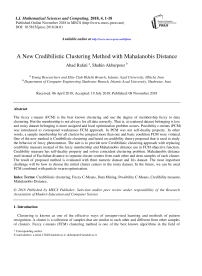A new credibilistic clustering method with mahalanobis distance
Автор: Ahad Rafati, Shahin Akbarpour
Журнал: International Journal of Mathematical Sciences and Computing @ijmsc
Статья в выпуске: 4 vol.4, 2018 года.
Бесплатный доступ
The fuzzy c-means (FCM) is the best known clustering and use the degree of membership fuzzy to data clustering. But the membership is not always for all data correctly. That is, at scattered dataset belonging is less and noisy dataset belonging is more assigned and local optimization problem occurs. Possibility c-means (PCM) was introduced to correspond weaknesses FCM approach. In PCM was not self-duality property. In other words, a sample membership for all clusters be assigned more than one and basic condition FCM were violated. One of the new method is Credibilistic clustering and based on credibility theory proposed that is used to study the behavior of fuzzy phenomenon. The aim is to provide new Credibilistic clustering approach with replacing credibility measure instead of the fuzzy membership and Mahalanobis distance use in FCM objective function. Credibility measure has self-duality property and solves coincident clustering problem. Mahalanobis distance used instead of Euclidian distance to separate cluster centers from each other and dens samples of each cluster. The result of proposed method is evaluated with three numeric dataset and Iris dataset. The most important challenge will be how to choose the initial cluster centers in the noisy dataset. In the future, we can be used FCM combined with particle swarm optimization.
Credibilistic clustering, Fuzzy C-Means, Data Mining, Possibility C-Means, Credibility measure, Mahalanobis Distance
Короткий адрес: https://sciup.org/15016676
IDR: 15016676 | DOI: 10.5815/ijmsc.2018.04.01
Список литературы A new credibilistic clustering method with mahalanobis distance
- P. Wen, J. Zhou, and L. Zheng, “A modified hybrid method of spatial credibilistic clustering and particle swarm optimization,” Soft Comput., vol. 15, no. 5, pp. 855–865, 2011.
- A. Proceedings, A. F. Shapiro, and M. Koissi, “Credibility Theory in a Fuzzy Environment,” 2013.
- R. Krishnapuram and J. M. Keller, “A Possibilistic Approach to Clustering,” IEEE Trans. Fuzzy Syst., vol. 1, no. 2, pp. 98–110, 1993.
- M. S. Yang and K. L. Wu, “Unsupervised possibilistic clustering,” Pattern Recognit., vol. 39, no. 1, pp. 5–21, 2006.
- M. Rostam Niakan Kalhori, M. H. Fazel Zarandi, and I. B. Turksen, “A new credibilistic clustering algorithm,” Inf. Sci. (Ny)., vol. 279, pp. 105–122, 2014.
- L. Wang, Y. Liu, X. Zhao, and Y. Xu, “Particle Swarm Optimization for Fuzzy c-Means Clustering,” Sixth World Congr. Intell. Control Autom. 2006. WCICA 2006, pp. 6055–6058, 2006.
- B. Liu, “A survey of credibility theory,” Fuzzy Optim. Decis. Mak., vol. 5, no. 4, pp. 387–408, 2006.
- J. Zhou, Q. Wang, C.-C. Hung, and X. Yi, “Credibilistic Clustering: The Model and Algorithms,” Int. J. Uncertainty, Fuzziness Knowledge-Based Syst., vol. 23, no. 04, pp. 545–564, 2015.
- D. Wang, B. Han, and M. Huang, “Application of Fuzzy C-Means Clustering Algorithm Based on Particle Swarm Optimization in Computer Forensics,” Phys. Procedia, vol. 24, pp. 1186–1191, 2012.
- H. Izakian and A. Abraham, “Optimization,” pp. 1690–1694, 2009.
- Z. Shi, “A Fuzzy Model of Scenario Planning Based on the Credibility Theory And Fuzzy Programming,” no. Isora, pp. 211–218, 2011.
- J. C. Bezdek, R. Ehrlich, and W. Full, “FCM: The fuzzy c-means clustering algorithm,” Comput. Geosci., vol. 10, no. 2–3, pp. 191–203, 1984.
- T. a. Runkler and C. Katz, “Fuzzy Clustering by Particle Swarm Optimization,” 2006 IEEE Int. Conf. Fuzzy Syst., no. 3, pp. 601–608, 2006.
- N. R. Pal, K. Pal, J. M. Keller, and J. C. Bezdek, “A possibilistic fuzzy c-means clustering algorithm,” IEEE Trans. Fuzzy Syst., vol. 13, no. 4, pp. 517–530, 2005.
- H. Izakian and A. Abraham, “Fuzzy C-means and fuzzy swarm for fuzzy clustering problem,” Expert Syst. Appl., vol. 38, no. 3, pp. 1835–1838, 2011.
- K. E. Permana and S. Z. M. Hashim, “Fuzzy membership function generation using particle swarm optimization,” Int. J. Open Probl. Compt. Math, vol. 3, no. 1, 2010.
- W. Pedrycz, Conditional fuzzy C-means, Patt. Recogn. Lett. 17 (1996) 625–631.
- W. Pedrycz, J. Waletzky, Fuzzy clustering with partial supervision, IEEE Trans. Syst. Man Cybernet. B: Cybernet. 27 (1997) 787–795.
- W. Pedrycz, Collaborative and knowledge-based fuzzy clustering, Int. J. Innov. Comput. 3 (2007) 1–12.
- L. Liu, S. Z. Sun, H. Yu, X. Yue, and D. Zhang, “A modified Fuzzy C-Means (FCM) Clustering algorithm and its application on carbonate fluid identification,” J. Appl. Geophys., 2016.
- C. Hai-peng, S. Xuan-jing, L. Ying-da, and L. Jian-wu, “A novel automatic fuzzy clustering algorithm based on soft partition and membership information,” Neurocomputing, no. September, pp. 1–9, 2016.
- N. Lekhi, M. Mahajan, “Outlier Reduction using Hybrid Approach in Data Mining,” I.J. Modern Education and Computer Science, 2015, 5, 43-49.
- Z. Hu, Y. V. Bodyanskiy, Oleksii K. Tyshchenko and Vitalii M. Tkachov, “Fuzzy Clustering Data Arrays with Omitted Observations,” I.J. Modern Education and Computer Science, 2017, 6, 24-32.


